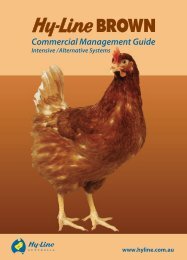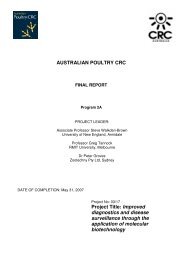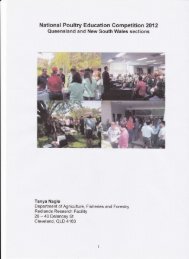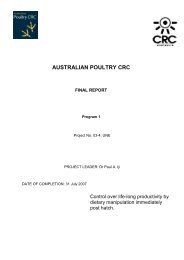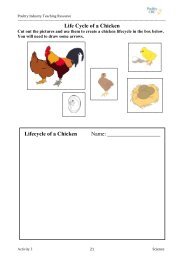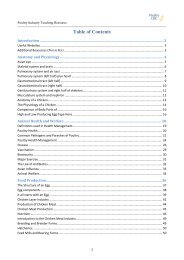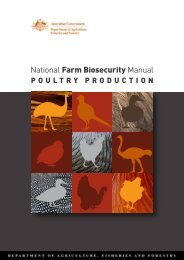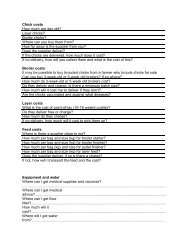The Producer - Poultry Hub
The Producer - Poultry Hub
The Producer - Poultry Hub
You also want an ePaper? Increase the reach of your titles
YUMPU automatically turns print PDFs into web optimized ePapers that Google loves.
<strong>The</strong> <strong>Producer</strong><br />
Who produces meat<br />
chickens<br />
<strong>The</strong> <strong>Producer</strong><br />
During the past many families owned<br />
their own flock of hens to supply them with<br />
meat and eggs.<br />
Today, in Australia, most chicken meat<br />
production is carried out as an intensive<br />
livestock enterprise by commercial<br />
producers. <strong>The</strong> Australian chicken meat<br />
and egg industries are separate industries<br />
that use different chicken breeds, housing<br />
and production systems. <strong>The</strong> two industries<br />
are owned and managed by separate<br />
groups of people.<br />
Contract chicken growers produce most of Australia’s meat chickens<br />
Q’land Chicken Growers’ Assoc. Inc.<br />
Chicken producers<br />
<strong>The</strong>re are currently more than<br />
800 commercial meat chicken growers<br />
in Australia. Most grow chickens under<br />
contract to meat processing companies and<br />
are known as ‘contract chicken growers’.<br />
<strong>The</strong>se producers grow 80 per cent of<br />
Australia’s meat chickens.<br />
Growers usually own their farms and<br />
provide the management, shedding,<br />
equipment, labour, bedding and other<br />
supplies needed to produce meat chickens.<br />
Contract growers are paid a growing fee<br />
per bird by the chicken meat processing<br />
company they supply. <strong>The</strong> processing<br />
company provides and owns the chickens<br />
and supplies the feed, medication and<br />
technical advice to the contract growers.<br />
DID YOU<br />
KNOW<br />
A typical family-owned<br />
modern meat chicken farm<br />
requires an investment of $4 –5 million<br />
and produces more than one million meat<br />
chickens each year, in several batches.<br />
Today most meat chicken production is intensive<br />
Processors work closely with contract growers<br />
Australian Chicken Meat Federation Inc.<br />
Ruralphotos.com<br />
14
Chicken meat processors<br />
Australian chicken meat is supplied to<br />
domestic consumers by three large chicken<br />
processing companies, 10 medium-sized<br />
companies and a wide range of smaller<br />
processors.<br />
Commonly recognised processor brands<br />
include: Inghams, Steggles, Baiada,<br />
Cordina, Red Lea, Golden Cockerel,<br />
Hazeldene’s, La Ionica, Adelaide <strong>Poultry</strong>,<br />
Gourmet <strong>Poultry</strong> and Sunnybrand.<br />
<strong>The</strong> three largest processing companies<br />
supply almost 80% of the chicken meat<br />
consumed in Australia.<br />
Larger chicken meat processors own<br />
their own breeder farms, hatcheries<br />
and feed mills and some have their own<br />
laboratories to test for common poultry<br />
diseases and pathogens.<br />
<strong>The</strong>se companies also carry out research<br />
into developing new chicken meat products<br />
for consumers.<br />
Some processing companies have their<br />
own rearing farms on which they grow<br />
some or all of the meat chickens they<br />
process. But most processors employ<br />
contract chicken growers who have their<br />
own rearing farms. A single processing<br />
company will get their meat chickens from<br />
a number of different contract growers.<br />
<strong>The</strong> flow of chicken from the producer to the consumer<br />
Breeder<br />
feed<br />
Meat<br />
chicken<br />
feed<br />
FEED MILL<br />
FURTHER PROCESSING<br />
Further<br />
processed<br />
/cooked<br />
products<br />
Imported<br />
fertile eggs<br />
QUARANTINE FACILITY<br />
Whole or<br />
cut-up dressed<br />
chicken<br />
Hatched chickens<br />
from imported eggs<br />
DISTRIBUTOR<br />
BREEDER FARMS<br />
MEAT CHICKEN REARING FARMS<br />
Day-old<br />
breeder chicks<br />
Market-age<br />
meat chickens<br />
PROCESSING PLANT<br />
Nine-week-old<br />
breeder chickens<br />
HATCHERY<br />
Day-old meat<br />
chickens<br />
Surplus<br />
breeders<br />
Fertile<br />
eggs<br />
Whole<br />
or cut-up<br />
dressed<br />
chicken<br />
<strong>The</strong> <strong>Producer</strong><br />
DID YOU<br />
KNOW<br />
All processing companies in<br />
Australia that supply chicken<br />
meat to Australian consumers are<br />
Australian-owned.<br />
RETAIL OUTLET<br />
CONSUMER<br />
FOOD SERVICE<br />
15
<strong>The</strong> <strong>Producer</strong><br />
Where are meat<br />
chickens grown<br />
Most commercial chicken meat<br />
production is carried out close to cities<br />
or large towns, where large numbers of<br />
consumers live. This reduces the cost of<br />
transporting chickens to meat processing<br />
plants and chicken meat from processing<br />
plants to consumers.<br />
History of commercial production<br />
Australia’s commercial chicken meat<br />
industry was first developed on the outskirts<br />
of Sydney, New South Wales. Other<br />
areas of production soon followed around<br />
other major population areas.<br />
During the 1950s, the size of the<br />
industry increased almost seven-fold.<br />
<strong>The</strong> industry expanded further during the<br />
1960s as businesses that owned breeding<br />
and hatching operations, feed mills and<br />
chicken processing plants developed.<br />
<strong>The</strong>se businesses contracted out the<br />
growing of meat chickens to specialist<br />
chicken growers.<br />
Chicken production has increased since the 1950s<br />
Australian Chicken Meat Federation Inc.<br />
Chicken meat production by state in Australia<br />
Number of chickens produced* = 460 million<br />
NSW VIC QLD SA WA TAS<br />
Percentage per state** (%) 34.3 27.9 18.3 9.1 9.0 1.4<br />
Chicken meat produced* = 816,000 tonnes<br />
Percentage per state** (%) 34.9 28.8 17.0 9.3 8.7 1.3<br />
Source: * Australian Bureau of Statistics 2007<br />
**Australian Chicken Meat Federation estimates of 2007 production.<br />
Chickens produced (%)<br />
35<br />
30<br />
25<br />
20<br />
15<br />
10<br />
5<br />
0<br />
Number of chickens produced<br />
States of Australia<br />
Total annual chicken<br />
production in Australia<br />
= 460 million<br />
Total annual chicken meat<br />
production in Australia<br />
= 816,000 tonnes<br />
Perth<br />
9.0%<br />
Darwin<br />
WESTERN<br />
AUSTRALIA<br />
8.7%<br />
NSW<br />
VIC<br />
QLD<br />
SA<br />
WA<br />
TAS<br />
Chickens produced (%)<br />
35<br />
30<br />
25<br />
20<br />
15<br />
10<br />
5<br />
0<br />
NORTHERN<br />
TERRITORY<br />
SOUTH AUSTRALIA<br />
Amount of chicken meat produced<br />
QUEENSLAND<br />
17.0%<br />
9.1%<br />
9.3%<br />
34.9%<br />
34.3%<br />
Adelaide<br />
28.8%<br />
27.9%<br />
Melbourne<br />
1.3%<br />
18.3%<br />
NEW SOUTH WALES<br />
1.4%<br />
VICTORIA<br />
TASMANIA<br />
Hobart<br />
NSW<br />
VIC<br />
QLD<br />
SA<br />
WA<br />
TAS<br />
Brisbane<br />
Sydney<br />
16
Chicken meat<br />
production<br />
<strong>The</strong> stages involved in chicken meat production<br />
1<br />
Breeder farm<br />
2<br />
Hatchery<br />
3<br />
Hatchery<br />
Producing chicken meat involves a<br />
wide range of activities. <strong>The</strong>se activities<br />
start at the breeder farms where parent<br />
hens are mated with cockerels to produce<br />
fertile eggs, and finish at the processing<br />
plants where chicken meat is processed,<br />
packaged and distributed to the market.<br />
From the breeder farms on which they<br />
are laid, fertile eggs are transported to a<br />
hatchery, where they are incubated until<br />
the chicks hatch.<br />
From the hatchery, day-old chicks are<br />
carefully transported to meat chicken<br />
rearing farms (often called grow-out farms).<br />
Here, chicken producers keep the chickens<br />
in purpose-built rearing sheds with a<br />
continuous supply of fresh water and food.<br />
• Parent hens are mated with<br />
cockerels to produce fertilised eggs<br />
• Fertile eggs are sent to a hatchery.<br />
ACMF Inc.<br />
• Fertile eggs are incubated under<br />
carefully controlled conditions to<br />
maintain a constant temperature<br />
and humidity.<br />
• After the chicks hatch, they<br />
are counted, packed and<br />
transported by road or air to<br />
rearing farms.<br />
4 Rearing farm 5 Rearing farm 6 Processor<br />
• Day-old chicks are housed in large<br />
well-ventilated sheds. <strong>The</strong> chicks run<br />
on the floor which is covered with a<br />
comfortable bedding material.<br />
• Growing chickens remain in the<br />
rearing sheds until they reach<br />
market weight and are then<br />
harvested.<br />
ACMF Inc.<br />
• When target sizes and weights<br />
are reached, the meat chickens<br />
are transported to a processing<br />
plant.<br />
ACMF Inc.<br />
<strong>The</strong> <strong>Producer</strong><br />
Chicken growers maintain the<br />
temperature and air quality of rearing<br />
sheds to ensure the chickens are<br />
comfortable. Growers manage their farms<br />
carefully to ensure the growing chickens<br />
remain strong and gain weight quickly.<br />
Ruralphotos.com<br />
ACMF Inc.<br />
ACMF Inc.<br />
When the meat chickens reach a size<br />
that is suitable for processing, they are<br />
transported from the rearing farms to the<br />
processing plant. After processing, chicken<br />
meat is prepared for sale for consumers.<br />
DID YOU<br />
KNOW<br />
In Australia, more than<br />
1.4 million meat chickens are<br />
hatched every day.<br />
17
<strong>The</strong> <strong>Producer</strong><br />
Meat chicken farms<br />
In Australia, meat chickens are grown<br />
out on rearing farms in large poultry barns<br />
that are usually called sheds.<br />
Shed sizes vary, but a typical new shed<br />
could be 150 metres long and 15m wide.<br />
A new rearing farm might have eight sheds<br />
each holding about 40,000 chickens<br />
— with the whole farm housing about<br />
320,000 chickens per batch. Each farm<br />
will produce between five and six batches<br />
of meat chickens each year.<br />
Meat chickens are raised in large sheds<br />
Australian Chicken Meat Federation Inc.<br />
Large fans draw fresh air through the shed<br />
Silos store and supply food to the sheds<br />
Australian Chicken Meat Federation Inc.<br />
Australian Chicken Meat Federation Inc.<br />
Food is supplied through feed lines and pans<br />
Chickens press their beaks to drinkers for water<br />
Photos: Australian Chicken Meat Federation Inc.<br />
Australian Chicken Meat Federation Inc.<br />
What is it like inside a shed<br />
Older-style meat chicken sheds are<br />
naturally ventilated with the sides open<br />
to fresh air. <strong>The</strong> amount of air passing<br />
through the shed is changed by raising or<br />
lowering curtains or shutters on the side<br />
openings. Stirring fans are fitted inside<br />
the sheds to encourage air flow. Water<br />
misting systems are fitted to cool birds by<br />
evaporative cooling in hot conditions.<br />
Most modern meat chicken sheds in<br />
Australia have tunnel ventilation. Air is<br />
drawn at high speed through cooling<br />
pads in the walls of one end of the shed,<br />
over the chickens and out through large<br />
extraction fans at the other end of the<br />
shed.<br />
Temperature sensors in the sheds monitor<br />
conditions and report to the shed computer<br />
controller, which automatically adjusts the<br />
fans as often as every three minutes to<br />
provide the best shed temperature and<br />
air quality.<br />
Feed lines and feed pans run the<br />
length of the shed. Automatic machines<br />
called augers transfer feed from storage<br />
silos outside the sheds into the feed lines<br />
and pans.<br />
Water lines also run the length of the<br />
shed, and drinkers are provided at regular<br />
intervals. Drinkers can have either nipples<br />
that release water when the chickens press<br />
them with their beaks or cups that fill when<br />
the chickens peck at the bottom of the cup.<br />
Feed and water lines are placed<br />
throughout the shed so chickens always<br />
have easy access to food and water.<br />
22
Preparing the shed<br />
Before the day-old chickens arrive at the<br />
rearing farms, growers prepare the sheds<br />
by spreading a thick layer of bedding<br />
material such as sawdust, wood shavings or<br />
rice hulls, across the shed floor. <strong>The</strong> shed is<br />
pre-heated and the feed and water systems<br />
are checked.<br />
On arrival, the chicks are placed onto<br />
the floor of the shed. To start with they are<br />
kept in an area of between one third to a<br />
half of the total shed area. This is called the<br />
brooding area.<br />
<strong>The</strong> chicks are kept warm with heating<br />
from gas heaters. This is called brooding<br />
and the heaters are referred to as brooders.<br />
Extra feed pans and drinkers are provided<br />
in the brooding area and the bedding is<br />
partly covered with paper on which extra<br />
feed is placed. This ensures the chicks find<br />
feed quickly while they are learning to eat<br />
from the feeders.<br />
For the first two days of the flock’s life,<br />
the shed temperature is kept at about 33°C,<br />
which is the best temperature for baby chick<br />
comfort and health. As the chickens grow<br />
they need less heat to keep them warm, so<br />
the temperature of the shed is gradually<br />
lowered.<br />
DID YOU<br />
KNOW<br />
Meat chickens are never<br />
kept in cages but instead run<br />
freely on the floor of the shed which is<br />
covered with a comfortable bedding<br />
material called litter.<br />
Fresh, clean bedding is spread on the shed floor<br />
Chicks are released into a newly prepared shed<br />
Chicks quickly learn to eat from the feed pans<br />
Australian Chicken Meat Federation Inc.<br />
Leonie Scarlett, Ruralphotos.com<br />
Australian Chicken Meat Federation Inc.<br />
Are male or female chickens<br />
raised as meat chickens<br />
Both male and female chicks are reared<br />
as meat chickens. Often the flocks are<br />
of mixed sex. <strong>Producer</strong>s tell the sex<br />
of chicks from their wing feathers (see<br />
below). Some producers rear male and<br />
female chickens separately, either in<br />
separate sections of the same shed or<br />
in separate sheds or farms. Male chicks<br />
grow slightly faster than female chicks<br />
and segregating them can help manage the<br />
feeding and harvesting programmes.<br />
Drinkers provide plenty of water for the chicks<br />
Australian Chicken Meat Federation Inc.<br />
Australian Chicken Meat Federation Inc.<br />
<strong>The</strong> <strong>Producer</strong><br />
23
<strong>The</strong> <strong>Producer</strong><br />
Growers check birds regularly to ensure they are healthy and behaving, eating and drinking normally<br />
Leonie Scarlett, Ruralphotos.com<br />
Why is animal welfare important<br />
to the meat chicken industry<br />
<strong>The</strong>re are three main reasons why animal<br />
welfare is important to the meat chicken<br />
industry:<br />
1. Out of respect for the animals<br />
themselves, so they do not suffer.<br />
2. So the birds grow as well as possible<br />
and are not damaged in the process.<br />
3. Because the industry recognises<br />
and respects community attitudes<br />
and expectations with regard to the<br />
humane treatment of livestock farmed<br />
specifically for their consumption.<br />
Animal welfare<br />
Animal welfare means different things to<br />
different people, but is mainly concerned<br />
with the treatment of animals to ensure<br />
their health and wellbeing.<br />
Consumers of animal products such as<br />
meat, milk and eggs demand that animals<br />
are kept healthy and cared for properly.<br />
Bird welfare is an essential part of the<br />
daily activities of all meat chicken growers.<br />
Using the best animal welfare practices<br />
ensures growers meet their responsibilities<br />
to the birds in their care.<br />
A high standard of animal welfare is<br />
good for business, as only healthy,<br />
well-cared-for animals grow at their best.<br />
<strong>The</strong> standards for treatment of animals<br />
during all stages of meat chicken<br />
production and processing are set down<br />
in codes and guidelines supported by the<br />
government and the meat chicken industry.<br />
<strong>The</strong>se standards have been developed to<br />
safeguard the chickens’ welfare.<br />
When growing meat chickens it is<br />
important the birds receive fast and<br />
appropriate treatment to prevent diseases<br />
or treat them if this becomes necessary.<br />
It also is important chickens do not suffer<br />
any unnecessary pain, distress, fear or<br />
physical injury. Sick or injured birds that<br />
cannot be treated need to be culled in a<br />
humane manner so they do not suffer.<br />
How are chickens killed<br />
Meat chickens are raised for human<br />
consumption and have to be killed<br />
(slaughtered) so the meat can be<br />
harvested. This is done in a humane<br />
manner. All chickens are stunned before<br />
they are killed. This means they are made<br />
unconscious and unable to feel pain.<br />
32
Free range and<br />
organic production<br />
A relatively small, but important,<br />
proportion of meat chickens in Australia<br />
is grown using alternative production<br />
systems, such as free range and organic,<br />
to meet consumer demands for chicken<br />
meat products in these ranges.<br />
In Australia, the market for free range<br />
chicken meat represents about 3% of all<br />
chicken meat produced. <strong>The</strong> market for<br />
organic meat is thought to be about 0.5%.<br />
What are free range chickens<br />
Free range meat chickens are produced<br />
using similar management, housing<br />
and feeding practices as those used for<br />
conventional meat chickens.<br />
<strong>The</strong> main differences between the<br />
systems are that free range chickens have<br />
access to an outside run for part of the<br />
day, have lower numbers of chickens<br />
per shed and some health issues are<br />
managed differently. For example, routine<br />
vaccination is not permitted unless required<br />
by law or where it is not possible to control<br />
diseases with other management practices<br />
such as biosecurity.<br />
DID YOU<br />
KNOW<br />
No hormones or steroids<br />
are used in any chicken<br />
meat production systems in Australia<br />
regardless of whether the label on the<br />
end product says so.<br />
Free range chickens are allowed access to an outside run for part of the day<br />
Chicken meat marketed as free range<br />
cannot come from chickens that have been<br />
treated with antibiotics. Antibiotics can be<br />
used under veterinary direction to treat sick<br />
birds but, after treatment, the meat from<br />
these birds cannot be labelled as free range.<br />
One of the main certifiers of free range<br />
chicken meat in Australia is Free Range<br />
Egg and <strong>Poultry</strong> Australia Ltd (FREPA).<br />
Free range chicken<br />
Australian Chicken Meat Federation Inc.<br />
Organic chicken<br />
Australian Chicken Meat Federation Inc.<br />
What are organic chickens<br />
In addition to the requirements for free<br />
range meat chickens, certified organic<br />
meat chickens must receive feed that has<br />
mostly come from ingredients that have<br />
been certified organic (for example,<br />
crops grown without the use of artificial<br />
herbicides or pesticides).<br />
Some additional requirements have to be<br />
met with regards to the use of chemicals<br />
on farm and in processing. <strong>The</strong>re also are<br />
requirements about the age of the chickens<br />
at harvest.<br />
Chicken meat that has been certified<br />
as organic will have a certification logo<br />
on the packaging from an organisation<br />
approved by the Australian Quarantine<br />
Inspection Service (AQIS).<br />
Australian Chicken Meat Federation Inc.<br />
<strong>The</strong> <strong>Producer</strong><br />
33
<strong>The</strong> <strong>Producer</strong><br />
Processing<br />
Meat chickens are killed using the<br />
most advanced technology and humane<br />
techniques available.<br />
<strong>The</strong> chicken carcases are processed to<br />
transform them into meat products. <strong>The</strong>se<br />
products are delivered to wholesalers,<br />
retailers and food service outlets.<br />
Of the live chicken, about 70% by<br />
weight can be converted to chicken meat<br />
products for people to eat.<br />
What is processing<br />
Processing involves converting the<br />
live animal into edible meat products and<br />
a range of byproducts.<br />
2<br />
Cleaning<br />
<strong>The</strong> plucked carcases are thoroughly<br />
cleaned after automatic equipment has<br />
removed the feet, heads, digestive tract<br />
and other internal organs.<br />
3<br />
Chilling<br />
Pieces<br />
4 Cutting and filleting<br />
Whole<br />
1 Plucking 2 Cleaning 3 Chilling 4 Grading chickens 5 Packaging<br />
<strong>The</strong> cleaned carcases are chilled<br />
rapidly in either iced water containing<br />
chlorine (to kill germs) or in chilled air in<br />
a room called an air chiller.<br />
5<br />
Value adding<br />
1<br />
Plucking<br />
After the chickens have been killed the<br />
chicken carcases are defeathered. <strong>The</strong>y<br />
are first passed through hot water to<br />
loosen the feathers. Automatic equipment<br />
then plucks the feathers from the chickens.<br />
Stork Food Systems, <strong>The</strong> Netherlands<br />
PHOTOS: Stork Food Systems, <strong>The</strong> Netherlands<br />
Linco Food Systems<br />
Stork Food Systems, <strong>The</strong> Netherlands<br />
During plucking all feathers are removed<br />
Birds are cleaned thoroughly before chilling<br />
Cleaned carcases are rapidly chilled<br />
34
5 Packing into<br />
cartons or trays 5 Bulk packing 5 Chilling and storage<br />
6 Distribution<br />
4<br />
DID YOU<br />
KNOW<br />
<strong>The</strong> largest processing plant<br />
in Australia processes about<br />
700,000 meat chickens per week and<br />
employs 720 people.<br />
Grading, cutting and filleting<br />
<strong>The</strong> chicken carcases are graded for<br />
size and inspected for quality. Some<br />
are removed for packaging as whole<br />
chickens. <strong>The</strong> remaining carcases are further<br />
processed. Some are cut into pieces such as<br />
legs, wings and thighs. Some carcases can<br />
be filleted, which involves removing meat<br />
such as breast and thigh fillets from the bone.<br />
Carcases are processed inside the plant room<br />
Australian Chicken Meat Federation Inc.<br />
Carcases can be packaged as whole chickens<br />
Other carcases are cut into legs, wings and thighs<br />
Breast meat can be removed as fillets<br />
Australian Chicken Meat Federation Inc.<br />
Stork Food Systems, <strong>The</strong> Netherlands<br />
Australian Chicken Meat Federation Inc.<br />
5<br />
Packaging and value adding<br />
Whole chickens are usually vacuum<br />
packed while chicken pieces and fillets<br />
are packaged onto plastic wrapped<br />
supermarket trays or as bulk lots into tubs<br />
or plastic-lined cartons or boxes. <strong>The</strong><br />
trays and cartons of chicken meat products<br />
are then weighed, labelled and their bar<br />
codes scanned. <strong>The</strong> bar codes enable<br />
the products to be traced back to the<br />
processing plant and date of processing.<br />
Some chicken meat may be sent in bulk to<br />
further processing plants where they are<br />
made into a range of value-added products<br />
such as chicken nuggets.<br />
Chicken is packaged in cartons and labelled<br />
Some chicken is further processed<br />
6 Distribution<br />
Packaged chicken meat is loaded<br />
into refrigerated trucks for distribution to<br />
supermarkets and food outlets.<br />
Australian Chicken Meat Federation Inc.<br />
Stork Food Systems, <strong>The</strong> Netherlands<br />
<strong>The</strong> <strong>Producer</strong><br />
35



